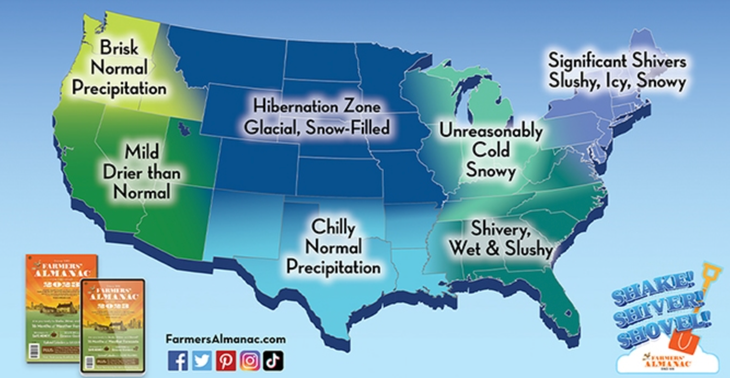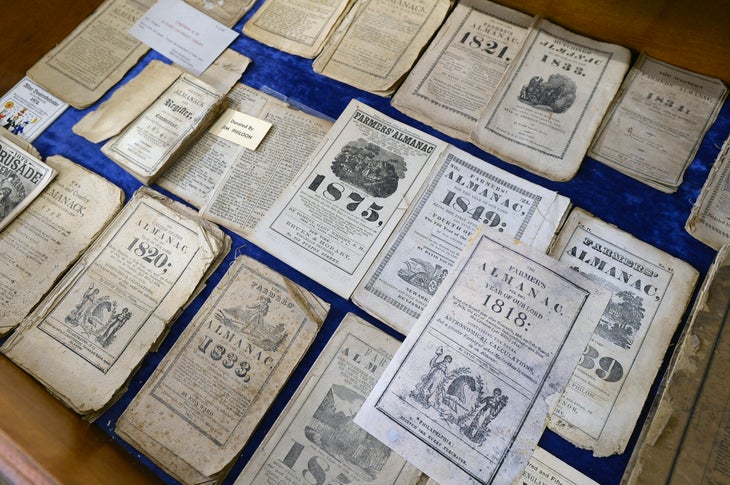Products You May Like
Get full access to Outside Learn, our online education hub featuring in-depth fitness, nutrition, and adventure courses and more than 2,000 instructional videos when you sign up for Outside+
Sign up for Outside+ today.
A group of secretive prognosticators. A close study of shifting sunspots and planets. A mysterious 200-year-old mathematical formula. Is this the makings of the next sci-fi blockbuster? Nope, just another day at The Farmers’ Almanac. According to their predictions, we skiers could be in for a banner season of frigid temps and frequent storm cycles.
Before you book those bucket-list ski trips, let’s dig a little deeper.

The Farmers’ Almanac and its competitor, The Old Farmer’s Almanac, have issued winter weather forecasts since their founding in 1818 and 1792, respectively. Historically, farmers relied on The Farmers’ Almanac and similar publications to guide their planting schedules. At the height of their popularity, there were as many as a couple hundred different Farmer’s Almanacs in print. The small hole in the upper left of these almanacs is a hold-out from this bygone era, allowing farmers to clip their copy to their belt loop so they had something to read when they hit the outhouse.
In more recent years, though, these old-school tomes have caught the attention of a more powder-crazed cohort: skiers. Some treat these forecasts as gospel; others are less convinced.
According to Peter Geiger, the current editor and owner of The Farmers’ Almanac, the publication has relied on the same weather prediction formula since 1818. “We’re using the same procedures and the same components as were used back in the earliest days of The Almanac,” says Geiger, who focuses more on editing than weather prediction. He also acknowledges that his prognosticators (a term The Almanac uses in lieu of meteorologist) have likely made some tweaks that reflect technological advances.
Go Deeper: What the Experts Say About This Winter’s Triple Dip La Niña
The formula Geiger speaks of was dreamt up by the founder of The Farmers’ Almanac, David Young. Information on Young is sparse; however, The Almanac states that he was an astronomer, poet, and teacher. Rumor has it he was hired by the French to figure out if there was an eclipse during the crucifixion of Jesus Christ, a task Young accomplished. (He determined that there wasn’t an eclipse that day.)
Evasiveness in discussing the specifics of The Farmers’ Almanac’s prediction techniques is part of the brand. The idea that an ancient mathematical formula could accurately predict our winters two years in advance is romantic, after all. But here’s what Geiger can say about The Farmers’ Almanac’s 200-year-old methods. Essentially, the prognosticators feed “sunspot activity, planet positions, [and] the effect that the Moon has on the Earth” into an equation whose exact machinations are a trade secret. Analysis of long-term weather patterns plays a role, too.

What of The Farmers’ Almanac’s accuracy, though? “I’m told that we’re somewhere between 75 and 85 percent accurate,” says Geiger. While the publication doesn’t officially publish its accuracy rates, they do discuss the success of previous forecasts in each edition of The Almanac.
Winter’s just barely getting going here, but The Almanac’s already nailed the timing of one early-season storm, calling for “heavy snows over CO, up to 18 inches over highest terrain, lesser amounts further north” between October 20 and 23. This prediction panned out—Colorado was hit with the first proper dump of the year on the weekend of October 22. Score one for The Almanac.
The Old Farmer’s Almanac, known for its yellowish cover, old-timey art style, and grocery store newsstand ubiquity, offers similar numbers. “Traditionally, we’re 80 percent accurate … some years are better than other years,” says Tim Goodwin, the publication’s associate editor.
As for recent winters, The Old Farmer’s Almanac claimed an overall accuracy rate of 72 percent for 2021 and 2022. Last season, they estimated the direction of precipitation departure by region with about 95 percent accuracy, and predicted temperature departure roughly 50 percent of the time. (“Departure” means the amount above or below the average.) They came to the 72 percent accuracy number by averaging those totals. For further clarity, The Old Farmer’s Almanac takes credit for a correct forecast if they predicted that snowfall or temperature was above or below average in a specific region, not if they guessed the exact departure from average.
Good enough to book flights? That’s your call.
While these accuracy rates sound promising, Alan Smith, a meteorologist with OpenSnow, cautions against relying on long-range forecasts, no matter who’s publishing them. “Long-range forecasts are fun to look at because they build up anticipation … unfortunately, they’re not very reliable in general,” he cautions.
Smith’s wariness aligns with contemporary research: A 2019 study found that highly specific forecast accuracy nosedives beyond the 10-day mark. Smith also says that sunspots, which in part guide the winter predictions of the Farmers’ Almanac and The Old Farmer’s Almanac, have a “very, very minimal impact” on terrestrial weather patterns.
Whether you trust or doubt them, The Farmers’ Almanac and The Old Farmer’s Almanac are decades-old institutions, prized for their quirkiness and commitment to antiquated sensibilities. Judging them by strict meteorological standards, while not unfair, may be missing the point.
Here are this season’s winter weather predictions from The Farmers’ Almanac and The Old Farmer’s Almanac. For more specific month-by-month forecasts, you can pick up copies of the almanacs at your local grocery, hardware, or farming goods store.
The Almanacs’ Winter Forecasts for Winter 2022-’23
The Farmers’ Almanac
Summary
The Farmers’ Almanac calls for a good season for us skiers. The tagline for the 2022 edition of the Almanac is “shake, shiver, and shovel.”
Detailed Outlook
The Farmers’ Almanac’s north central region, which comprises Utah, Montana, Wyoming, and Colorado, is slated to be a “hibernation zone” that is “glacial” and “snow-filled.” The publication also issued a winter storm warning for the north-central region in early January 2023. On the eastern side of the country, expect similarly frigid temperatures through December and January, culminating in another storm warning for late January. These chillier temps should taper off in February. Out West, the forecast is a little less skier friendly. The Pacific Northwest is categorized as “brisk” with “normal precipitation.” Mild, dry conditions are set to dominate the Southwest. These drier blips aside, Geiger thinks it’ll be “a really good year for skiers in most areas.”
The Old Farmer’s Almanac
Summary
The Old Farmer’s Almanac has a slightly less optimistic take on snowfall totals, saying we’re in for a “tale of two winters.” To them, the amount of powder days you can expect depends on which part of the country you reside in, with states east of the Rockies receiving the lion’s share of cold temps and snowfall.
Detailed Outlook
The Intermountain West region of The Old Farmer’s Almanac covers a large percentage of the U.S ski real estate, including Idaho, western Montana, western Wyoming, Utah, and western Colorado. In this region, anticipate a relatively normal ski season with above-average temperatures and precipitation. Mild temperatures and lower-than-normal snowfall are predicted to plague the western side of Washington, although precipitation should see an uptick towards the Cascades. As you move east, the prognosis is more promising. The Old Farmer’s Almanac calls for “shivery and snowy” conditions throughout much of the Midwest and the East Coast, although the northeast portion of Maine could be in for milder temps.
